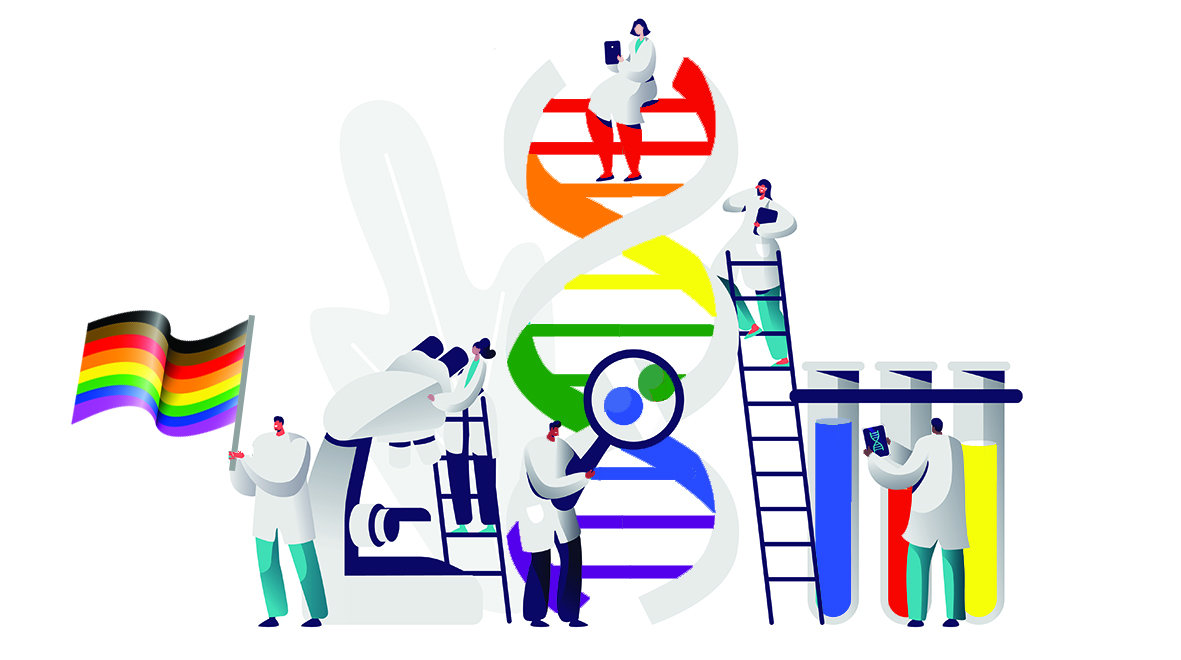
Karim Boustani argues the importance of making STEM LGBT-inclusive, from improving visibility to expanding diversity initiatives to include LGBT people.
A large barrier to the creation of an inclusive workplace in science, technology, engineering and mathematics (STEM), in my experience, is the view that being out is regarded as “unprofessional” because it is seen as too “personal”, even though most of our colleagues are “out” as being straight without issue. LGBT people tend to depoliticise themselves in the workplace because there is a commonly held view that discussions about inequality are not regarded as relevant to STEM work. The term “LGBT” will be used in this post to refer to anyone who identifies as lesbian, gay, bisexual, trans or intersex, or who does not conform to society’s expectations in terms of sexual or gender identity and expression.
The lack of lesbian, gay, bisexual and transgender (LGBT) diversity within STEM subjects is a longstanding issue that is too often left out of conversations about broadening participation in STEM. It is estimated that LGBT people are approximately 20 per cent less represented in STEM fields than expected. Additionally, male LGBT undergraduates are much less likely to stay in STEM degrees than straight men.
There is therefore an obvious issue with the recruitment and retention of LGBT individuals in STEM fields, and this can be detrimental to productivity. An inclusive culture helps to attract and retain talented researchers and diverse teams are more likely to reach scientific breakthroughs and innovations due to a variety of perspectives.
Heteronormative attitudes = a straight jacket for LGBT
There is strikingly little research on LGBT representation within STEM, not least because sexual identity is fluid and can be concealed. However, a recent report by the American Physical Society revealed that approximately 15 per cent of LGBT men, 25 per cent of LGBT women and 30 per cent of gender-nonconforming individuals felt “uncomfortable” or “very uncomfortable” within their department or division. The report also highlighted additional issues faced by LGBT professionals including a heterosexist culture (i.e. a culture that centres opposite-sex sexuality and relationships) which encourages LGBT people to remain isolated and/or closeted at work. These issues also disproportionately affected LGBT women and Black and Minority Ethnic (BME) individuals, who are also disadvantaged because of their sex and/or race. Finally, LGBT physicists reported difficulty in identifying allies. Crucially, though, they also said that when allies existed, they created safe and welcoming environments which helped to improve the professional climate.
These findings suggest three vital ways that STEM institutions should be fostering inclusive environments: first, by reducing heteronormative attitudes in the workplace, which can create an unconscious bias against LGBT individuals; second, by increasing visibility; and third, by providing sufficient mentoring and support from faculty members.
Community and visibility
Although no one should be obliged to be open about their sexual identity, it is difficult to create an inclusive and welcoming environment without visibility. Campaigns such as 500 Queer Scientists as well as campus-wide initiatives like rainbow lanyards are crucial in enhancing visibility. Additionally, the work organisations such as Pride in STEM are doing is extremely in important as it gives LGBT people working in STEM a sense of community and an opportunity to share their experiences. Imperial also has its own LGBT postgraduate and staff network – Imperial 600. Although these networks provide invaluable opportunities to unite LGBT people working in STEM, their members often work in a broad range of fields within STEM, making it difficult for LGBT biologists to meet other LGBT biologists and so on. This highlights the need for societies and conferences to be more proactive in bringing their LGBT members together.
LGBT faculty staff-student mentoring schemes would also be invaluable, especially for students who do not feel comfortable disclosing their sexual identities. Although these may be difficult to implement given the low numbers of LGBT faculty staff at any single institution, larger professional networks could be created across multiple institutions. Further, non-LGBT staff should be offered ally training courses, which could educate them both about the struggles faced by their LGBT counterparts as well as how to speak out against negative and discriminatory comments in the workplace. These courses would also be important in disassembling heteronormative attitudes often present in departments, where it is assumed that individuals will be straight. These attitudes can manifest in microaggressions – the everyday and often unintentional communications revealing prejudice or ignorance towards LGBT people – and reinforce an inappropriately masculine atmosphere in STEM fields such as engineering and physics.
You forgot about gay…
It is important to note that many diversity programmes fail to include LGBT people. For example, the US National Institutes of Health encourages institutions to diversify faculties to enhance participation of individuals from nationally underrepresented groups, including racial and ethnic minority groups, individuals with disabilities, individuals from disadvantaged backgrounds and women. While these efforts are equally as vital and will benefit LGBT people who also belong to those groups, there is no similar scheme for LGBT people in general. Additionally, analyses by the National Science Foundation that monitor STEM participation do not monitor LGBT representation, meaning that data which could be used to influence diversity programmes is not being collected. Including LGBT people in these programmes should also help in increasing participation from other underrepresented groups.
 In order to improve the experiences of LGBT people in STEM, unconscious biases and heteronormative and dismissive attitudes must first be acknowledged, even by well-intentioned individuals. The LGBT community relies on a stable support network, made up of both fellow peers and non-LGBT allies. Societies need to play a more active role in uniting LGBT professionals and promoting potential mentoring schemes for staff and students. Above all, the view that sexual identity is irrelevant in STEM needs to be challenged because both the data and personal experiences suggest otherwise.
In order to improve the experiences of LGBT people in STEM, unconscious biases and heteronormative and dismissive attitudes must first be acknowledged, even by well-intentioned individuals. The LGBT community relies on a stable support network, made up of both fellow peers and non-LGBT allies. Societies need to play a more active role in uniting LGBT professionals and promoting potential mentoring schemes for staff and students. Above all, the view that sexual identity is irrelevant in STEM needs to be challenged because both the data and personal experiences suggest otherwise.
Karim Boustani (@karim_boustani) is a PhD student at the National Heart & Lung Institute within the Inflammation, Repair and Development section. As part of LGBT History Month 2019, Karim is highlighting different LGBT people working in STEM (either historic or current) every day of the month on Twitter.
Awesome blog Karem, I loved it!
I can’t simply go without leaving a comment. This post is a great read. I hope you can take the time to read my post as well The LGBTQ Community .
Thanks,